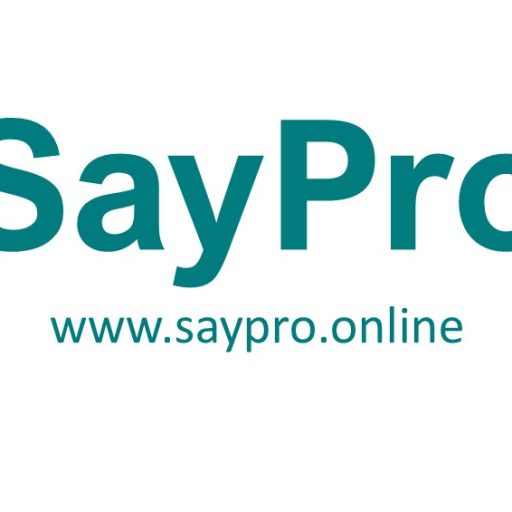Your cart is currently empty!
Tag: Practitioner
SayPro is a Global Solutions Provider working with Individuals, Governments, Corporate Businesses, Municipalities, International Institutions. SayPro works across various Industries, Sectors providing wide range of solutions.
Email: info@saypro.online Call/WhatsApp: Use Chat Button 👇

-

SayPro QCTO Occupational Certificate: Supply Chain Practitioner Training Material
SayPro Supply Chain Practitioner Training Material
1. Supply Chain Environments
- Lesson 1: Introduction to Supply Chain Environments
- Overview: Introduction to different supply chain environments such as manufacturing, retail, logistics, and e-commerce.
- Key Players: Identification of key stakeholders in each environment (e.g., suppliers, manufacturers, distributors, retailers, customers).
- Roles and Responsibilities: Understanding the roles and responsibilities of each stakeholder in the supply chain.
- Lesson 2: Challenges in Supply Chain Environments
- Common Challenges: Identification of common challenges such as supply chain disruptions, demand fluctuations, and inventory management issues.
- Strategies to Overcome Challenges: Techniques and strategies to mitigate these challenges, including risk management and contingency planning.
2. Supply Chain Operations
- Lesson 1: Basics of Supply Chain Operations
- Flow of Goods and Services: Understanding the flow of goods and services from suppliers to customers.
- Key Components: Identification of key components such as procurement, production, warehousing, and distribution.
- Processes and Activities: Detailed explanation of processes and activities involved in supply chain operations.
- Lesson 2: Managing Supply Chain Operations
- Efficient Management: Techniques for efficient supply chain management, including lean management and just-in-time (JIT) inventory.
- Tools and Technologies: Introduction to tools and technologies used in supply chain operations, such as supply chain management software and automation.
3. Supply Chain Workflow
- Lesson 1: Mapping Supply Chain Workflow
- Steps Involved: Detailed steps involved in the supply chain workflow, from order placement to delivery.
- Workflow Diagrams: Creating workflow diagrams to visualize the supply chain process.
- Process Mapping: Techniques for mapping and analyzing supply chain processes.
- Lesson 2: Optimizing Supply Chain Workflow
- Identifying Bottlenecks: Techniques for identifying bottlenecks and inefficiencies in the supply chain.
- Implementing Improvements: Strategies for implementing improvements to streamline workflow and enhance efficiency.
4. Inventory and Logistics Operations
- Lesson 1: Inventory Management Basics
- Types of Inventory: Different types of inventory (e.g., raw materials, work-in-progress, finished goods) and their management.
- Inventory Control Techniques: Techniques for effective inventory control, including reorder points and safety stock.
- Inventory Metrics: Key metrics for measuring inventory performance, such as inventory turnover and carrying costs.
- Lesson 2: Logistics Operations
- Transportation Strategies: Strategies for transportation and distribution, including route optimization and carrier selection.
- Warehouse Management: Best practices for warehouse management, including layout design and inventory tracking.
- Logistics Optimization: Techniques for optimizing logistics operations to reduce costs and improve delivery times.
5. Optimizing Supply Chain Relationships
- Lesson 1: Building Strong Supplier Relationships
- Importance of Supplier Relationships: Understanding the importance of strong supplier relationships for supply chain success.
- Supplier Management Strategies: Strategies for effective supplier management, including supplier evaluation and performance measurement.
- Collaboration and Communication: Techniques for fostering collaboration and communication with suppliers.
- Lesson 2: Enhancing Customer Relationships
- Customer Satisfaction: Techniques for improving customer satisfaction and loyalty.
- Managing Customer Expectations: Strategies for managing customer expectations and handling feedback.
- Customer Relationship Management (CRM): Introduction to CRM tools and practices for maintaining strong customer relationships.
- Lesson 1: Introduction to Supply Chain Environments